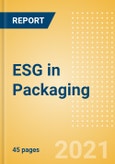Environmental, social, and governance (ESG) is the most important theme for 2021, and the next 10 years. Companies must excel across all three aspects of ESG. Social inequality, corruption, tax avoidance, and a lack of action on climate change are issues companies must address head-on in full public view. Packaging companies that fall behind the competition in ESG will see an exodus of customers moving to a more sustainable packaging provider and a drop in profits far sooner than they ever imagined.
This report offers expert market analysis, data, and comparisons of packaging companies’ ESG achievements and commitments, and highlights industry leaders and laggards.
The publisher's propriety ESG framework identifies 12 main areas of ESG, contributing factors to these areas, and mitigating actions that companies can take to excel in ESG. The report's trends section highlights the tech, macro, and industry trends impacting the ESG theme in the packaging sector over the next 12 to 24 months.
Scope
Reasons to Buy
This report offers expert market analysis, data, and comparisons of packaging companies’ ESG achievements and commitments, and highlights industry leaders and laggards.
The publisher's propriety ESG framework identifies 12 main areas of ESG, contributing factors to these areas, and mitigating actions that companies can take to excel in ESG. The report's trends section highlights the tech, macro, and industry trends impacting the ESG theme in the packaging sector over the next 12 to 24 months.
Scope
- Both regulators and non-governmental initiatives are progressing the packaging sector towards a circular economy. This means gradually decoupling economic activity from the consumption of finite resources and designing waste out of the system. Circular economy regulations have been around for decades and are gathering significant momentum.
- According to a survey from the publisher, environmentally friendly packaging material was a key driver of purchase for 34% of respondents, 44% stated that it was nice to have but not essential, and 22% indicated that it did not affect their purchasing behavior.
- According to the publisher’s 2019 Global Executives Survey: Plastic Packaging, Sustainability, and Disruption, 87% of respondents expected government legislation to impact plastic packaging dynamics, with 49% strongly agreeing with this expectation. Numerous initiatives and government policies are guiding the packaging sector towards a circular economy
Reasons to Buy
- Position yourself for the future and create a holistic ESG strategy using the publisher’s ESG framework. Assess sustainability policies, performance, and progress against the publisher’s ESG framework. Identify and mitigate factors that contribute to negative consequences and pursue actions to improve ESG performance.
- Uncover the packaging companies excelling in ESG operations with the publisher’s thematic scorecard. Understand competitor activity and positioning in the ESG theme with the extensive coverage of each leading company’s activity in the companies section.
- Use the trends section to identify key technology, macroeconomic, and regulatory trends shaping the ESG theme.
- Discover the key challenges to packaging companies across Environment, Social, and Governance, with company examples of mitigating actions and malpractice.
- Understand the ESG action feedback loop, a market mechanism that drives reputational and competitive advantage, incentivizing further action and drawing more participation.
Table of Contents
- Executive summary
- The Publisher’s ESG framework
- Trends
- The ESG action feedback loop
- ESG challenges in packaging
- Case studies
- ESG timeline
- Companies
- Sector scorecard
- Glossary
- Further reading
- Our thematic research methodology
- About the Publisher
- Contact the Publisher
Companies Mentioned (Partial List)
A selection of companies mentioned in this report includes, but is not limited to:
- Amcor
- Aptar
- SIG Combibloc
- Ball Corp
- Berry Global
- BlackRock
- Crown Holdings
- DS Smith
- International Paper
- O-I Glass
- Pactiv Evergreen
- Smurfit Kappa
- Stora Enso
- Tetra Pak
- UPM-Kymmene
- WestRock








